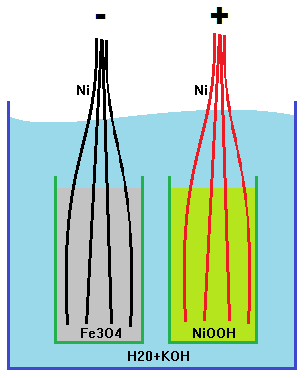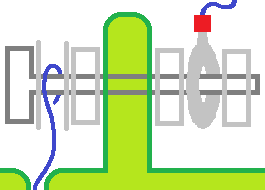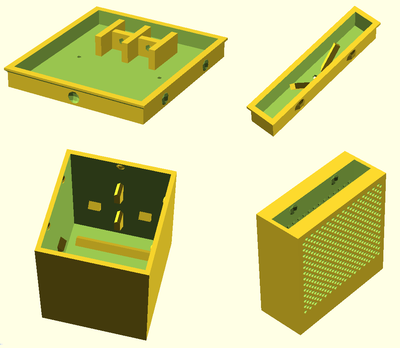User:Dorkmo/Ideas/Battery: Difference between revisions
< User:Dorkmo | Ideas
Jump to navigation
Jump to search
(→design) |
|||
| (46 intermediate revisions by 2 users not shown) | |||
| Line 1: | Line 1: | ||
[[Image:Battery-design-overview.png|400px|right]] | |||
idea is to use powder contained in tubs. the walls will have a perforated mesh whos holes angle up and out so that the powder cannot escape. Nickel wires will be placed in the powder to conduct out of the cell. -'''Contact area is not optimal - that's why they use liquid electrolyte?-MJ''' | |||
[ | *[[Nickel-Iron_Battery]] | ||
*[[Nickel-Iron_Battery/Chemistry]] | |||
**[http://en.wikipedia.org/wiki/Nickel%E2%80%93iron_battery#Electrochemistry Wikipedia] | |||
**[http://electronicspani.com/nickel-iron-battery/ electronicspani.com - NiFe Battery] | |||
[[ | [[User:Dorkmo/Log]] | ||
[http://drive.google.com/folderview?id=0BwxMMqGvwTM-dElBSUpQYWtMdnM&usp=sharing Google Docs Folder] | |||
=design= | =design= | ||
==principles== | |||
*maximize 3d printing | |||
**utilize parametric customization | |||
*avoid complicated chemical processing | |||
**no nickel plating | |||
==ideas== | ==ideas== | ||
*powders are very likely to become airborne | |||
**internet has suggested that "black strap molases" was added to edison batteries | |||
**might try to mix in at different ratios to see what happens to consitency | |||
*add a couple super capacitors to get some cold cranking amps? | *add a couple super capacitors to get some cold cranking amps? | ||
| Line 34: | Line 50: | ||
*need to make parametric for 10 tub battery | *need to make parametric for 10 tub battery | ||
**maybe input number of rows and columns so it can be a single row or two side by side | **maybe input number of rows and columns so it can be a single row or two side by side | ||
*might move side spacers onto cages. 3 sphere divots. 1 middle top and 2 side by side bottom, flip on opposite face. 1 or 2 on non mesh sides. | |||
==lessons learned== | |||
*3d printing with layers most often leads to leaks | |||
**can sometimes hold but not reliably. | |||
***perhaps in the future print settings could be optimized | |||
**need to use a regular plastic container for tub | |||
***perhaps half gallon milk jug | |||
==sketches== | ==sketches== | ||
| Line 41: | Line 67: | ||
[[File:BATTERY-idea-20141012.skp]] | [[File:BATTERY-idea-20141012.skp]] | ||
<html><iframe src="https://3dwarehouse.sketchup.com/embed.html?mid=ub3514fdf-5f46-459b-a0ed-433a83daab1f&width=400&height=300" frameborder="0" scrolling="no" marginheight="0" marginwidth="0" width="400" height="300" allowfullscreen></iframe></html> | |||
==scad work== | ==scad work== | ||
[[Image:Ose-battery-images-20141118-scad.png|400px]] | |||
parametric code to produce stl files for custom sized 3d prints. | |||
[[User:Dorkmo/Ideas/Battery/SCAD]] | [[User:Dorkmo/Ideas/Battery/SCAD]] | ||
| Line 48: | Line 80: | ||
==chemistry== | ==chemistry== | ||
http://en.wikipedia.org/wiki/Nickel%28II%29_hydroxide | :[http://en.wikipedia.org/wiki/Nickel%28II%29_hydroxide Nickel Hydroxide] | ||
:[[Nickel-Iron_Battery/Chemistry]] | |||
:[http://en.wikipedia.org/wiki/Nickel%E2%80%93iron_battery#Electrochemistry Wikipedia] | |||
:[http://electronicspani.com/nickel-iron-battery/ electronicspani.com - NiFe Battery] | |||
===KOH corrosion=== | |||
*need to find out if ABS or PLA or other plastics will hold up to corrosion by the electrolyte | |||
[http://www.roymech.co.uk/Useful_Tables/Corrosion/Corr_plastic.html chart] | |||
[http://www.lati.com/en/technical_data/chemical_resistance_01.html chart] | |||
==calculations== | ==calculations== | ||
*nickel hydroxide Ni(OH)2 | *nickel hydroxide Ni(OH)2 | ||
**4.10 g/cm3 | **4.10 g/cm3 | ||
===to research later=== | |||
:would liked to have an info for: | |||
::Ah/gram | |||
::impact surface area has | |||
::calculate AWG output based on dimensions of cage and cells | |||
=analysis= | |||
Need to find a battery analyzer. | |||
*[http://www.paulallenengineering.com/store/p2/2_Slot_AA_Charger%2C_Standard_SD_Data_Logging%2C_External_Drain%2C_With_Case.html UltraSmartCharger] | |||
=bom= | =bom= | ||
| Line 73: | Line 127: | ||
*nuts | *nuts | ||
** | ** | ||
==chemicals== | |||
*[http://www.sigmaaldrich.com/catalog/product/aldrich/283622?lang=en®ion=US Ni(OH)2] [http://www.gfschemicals.com/statics/productdetails/NICKEL_HYDROXIDE_5191.html] | |||
*[http://www.artistsupplysource.com/product/53758/potassium-hydroxide-caustic-potash-1-kg-2-2-lb-bag-made-in-usa-by-natural-pigments/?utm_source=AR-froogle_Product-Ads&utm_medium=Natural_Pigments&utm_campaign=NAP-500-21POH1K&gclid=CLLop8-ZrrYCFaFxQgodKhoAuQ&xid0=07b2299bc82b20977180722ece0cbc3f KOH] [http://www.amazon.com/Potassium-Hydroxide-Caustic-Potash-Flakes/dp/B00KCYOFCI/ref=sr_1_1?ie=UTF8&qid=1416543631&sr=8-1&keywords=potash+lye] | |||
*[http://www.amazon.com/Black-Iron-Oxide-Natural-Pounds/dp/B008LE63H6/ Fe3O4] [http://alphachemicals.com/] | |||
*[http://www.amazon.com/Dixon-Graphite-Microfyne-463-LMF1-Category/dp/B004F7JD5M/ C] [http://www.asburystore.com/SearchResults.asp?Cat=1814] | |||
[http://www.chemexper.com/search/cas/12054487.html supplier directory] | |||
==wire== | |||
*[http://www.temcoindustrialpower.com/search.html?category=Special_Metal_Wire Nickel Wire] | |||
==Misc== | |||
*[http://www.walmart.com/ip/Slow-As-Blackstrap-Molasses-32-oz-Pack-of-6/17770607 Molasses] | |||
=Notes= | |||
*internet sometimes suggests having 2:1 nickel hydroxide to iron ratio | |||
*initial charge | |||
**a few places have suggested that a short (30min) small charge happen 1 day before a full charge | |||
**couldnt find any info on why this would be | |||
==mixes== | |||
*it is suggested to add graphite to nickel hydroxide | |||
**internet says 17% graphite | |||
**will try 85% nickel hydroxide 15% graphite to keep it simple | |||
*one source said graphite is mixed into the iron | |||
**havent seen that suggested anywhere else | |||
*its also suggested that layers of nickel flake were used | |||
**multiple layers were pressed with hydraulic force | |||
*internet suggests 20-30% KOH in electrolyte | |||
**tolerant of different amounts | |||
===version 1=== | |||
:1 cup dry Ni hydroxide powder | |||
:1/4 cup dry graphite powder | |||
:then | |||
:1/4 cup black strap molases | |||
:3/16 cup water | |||
=FDM watertightness= | |||
http://www.stratasys.com/solutions/finishing-processes/sealing-fdm-parts | |||
epoxy resin to seal surfaces | |||
*instead use common LDPE containers? | |||
Latest revision as of 03:50, 21 November 2015
idea is to use powder contained in tubs. the walls will have a perforated mesh whos holes angle up and out so that the powder cannot escape. Nickel wires will be placed in the powder to conduct out of the cell. -Contact area is not optimal - that's why they use liquid electrolyte?-MJ
design
principles
- maximize 3d printing
- utilize parametric customization
- avoid complicated chemical processing
- no nickel plating
ideas
- powders are very likely to become airborne
- internet has suggested that "black strap molases" was added to edison batteries
- might try to mix in at different ratios to see what happens to consitency
- add a couple super capacitors to get some cold cranking amps?
- not sure if that would work but just an idea
- two tubs with grid on four sides of each or shared center.
- fins for surface area.
- cages that snap in to the bottom of a tub shared by two cages.
- might use a part of a sphere for the snap in idea.
- tub lid
- tub lid will need some sort of two pole terminal block
- from cages below
- to next tub or out for use
- might need some sort of cover for uninsulated wires from cage
- vent for gas?
- tub lid will need some sort of two pole terminal block
- need to make parametric for 10 tub battery
- maybe input number of rows and columns so it can be a single row or two side by side
- might move side spacers onto cages. 3 sphere divots. 1 middle top and 2 side by side bottom, flip on opposite face. 1 or 2 on non mesh sides.
lessons learned
- 3d printing with layers most often leads to leaks
- can sometimes hold but not reliably.
- perhaps in the future print settings could be optimized
- need to use a regular plastic container for tub
- perhaps half gallon milk jug
- can sometimes hold but not reliably.
sketches
single cell separated by a grid.
File:BATTERY-idea-20141012.skp
scad work
parametric code to produce stl files for custom sized 3d prints.
User:Dorkmo/Ideas/Battery/SCAD
chemistry
KOH corrosion
- need to find out if ABS or PLA or other plastics will hold up to corrosion by the electrolyte
calculations
- nickel hydroxide Ni(OH)2
- 4.10 g/cm3
to research later
- would liked to have an info for:
- Ah/gram
- impact surface area has
- calculate AWG output based on dimensions of cage and cells
analysis
Need to find a battery analyzer.
bom
hardware
nickel, aluminum, brass?
- all thread
- bolts
- washers
- nuts
chemicals
wire
Misc
Notes
- internet sometimes suggests having 2:1 nickel hydroxide to iron ratio
- initial charge
- a few places have suggested that a short (30min) small charge happen 1 day before a full charge
- couldnt find any info on why this would be
mixes
- it is suggested to add graphite to nickel hydroxide
- internet says 17% graphite
- will try 85% nickel hydroxide 15% graphite to keep it simple
- one source said graphite is mixed into the iron
- havent seen that suggested anywhere else
- its also suggested that layers of nickel flake were used
- multiple layers were pressed with hydraulic force
- internet suggests 20-30% KOH in electrolyte
- tolerant of different amounts
version 1
- 1 cup dry Ni hydroxide powder
- 1/4 cup dry graphite powder
- then
- 1/4 cup black strap molases
- 3/16 cup water
FDM watertightness
http://www.stratasys.com/solutions/finishing-processes/sealing-fdm-parts
epoxy resin to seal surfaces
- instead use common LDPE containers?


